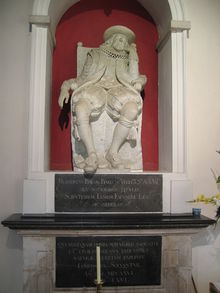- St Michael's Church, St Albans
-
St Michael's Church, St. Albans
St Michael's Church, St. AlbansDenomination Church of England Churchmanship Broad Church Website www.stmichaels-parishchurch.org.ukm History Dedication St. Michael Administration Parish St Albans Diocese St Albans Province Canterbury Clergy Vicar(s) Revd Brett Gray Laity Organist/Director of music Richard Bond St Michael's Church in St Albans is a parish church in the Church of England.
Contents
Background
It is, based upon the writing of Matthew Paris, believed to have been originally founded in AD948 by Abbot Ulsinus of St Albans. There is some uncertainty about both the date and the Abbot, but there is no real doubt that the church, together with St Stephen's and St Peter's churches, was built at about that time to receive pilgrims and to prepare them for their visit to the shrine of St Alban within St Albans Abbey (now St Albans Cathedral). The three churches, all of which still exist as active places of Christian worship, stand on the three main roads into St Albans. St Michael's lies among the foundations of the old basilica (law-court) of Roman Verulamium, where Alban was condemned to die. In sending the first missionaries to Britain, Pope Gregory the Great had instructed them to build churches on important pagan sites, and it seems likely that this edict influenced the siting of St Michael's.
Architecture
The original Anglo-Saxon church was likely to have been a simple timber structure, but was replaced soon enough (historians suggest around AD1000) by a more permanent building in flint and brick taken from the ruins of Verulamium. The Nave was a little shorter than at present, and the Chancel was much smaller. The outline of window openings in brick can be seen at a relatively low level inside the Nave and they can also be made out from the later North and South Aisles, as these walls were the original exterior walls of the 11th century structure.
The addition of the side aisles with their lean-to roofs in the early 12th century blocked off the first windows, and light had to be admitted to the interior of the church by new high-level clerestory windows. Access to the aisles was through new round-headed arches simply cut through the original walls. In the mid-13th century, the need for yet more space within the church led to the building of the Lady Chapel to the south-east, and this in turn blocked off the clerestory windows in the south-east corner of the church. The timber roof dates from the 15th century.
In more-or-less this form, St Michael's Church survived into the late 19th century, when Lord Grimthorpe[1] turned his attention to St Michael's. At his own expense, he extended the nave westwards and built the choir vestry on the south-west corner of the church and the tower on the north-west corner. The clock is also Grimthorpe's work and has a mechanism similar to that of the clock of the Palace of Westminster, responsible for the chimes of Big Ben. With minor modifications, St Michael's to-day is very much as Grimthorpe left it.
Fixtures and fittings
Two of the most noteworthy objects within St Michael's Church are connected with its most famous parishioner, Sir Francis Bacon.
- The Bacon monument (pictured right), possibly the work of Nicholas Stone, was erected to his memory by his devoted secretary Sir Thomas Meautys in 1630.
- Second only to this is the beautiful Elizabethan oak pulpit with its tester (sounding board) and hourglass. It is believed to have been removed from the Chapel at Old Gorhambury.
Another noteworthy feature is the remains of a medieval Doom painting. Although generally believed to date from the second half of the 15th century[2], some sources believe the surviving wooden tympanum actually dates from the end of the 13th.[3]
The organ dates from 1981 and is the work of Peter Collins. The two oak organ cases that stand either side of Grimthorpe's west window were retained from the 1950 Mander organ.
Modern times
The Church is still active today.
External links
See also
- Saint Michael
Footnote and references
- ^ Otherwise famous as a Queen's Counsel, parliamentarian, clockmaker and, most particularly, saviour of St Albans Cathedral (as the Abbey Church had become in 1877)
- ^ Doom webpage on official church website
- ^ St Michael's Doom — 13th Century Doom Painting on Wood
Categories:- 948 establishments
- Church of England churches in Hertfordshire
- Buildings and structures in St Albans
- History of St Albans
Wikimedia Foundation. 2010.


